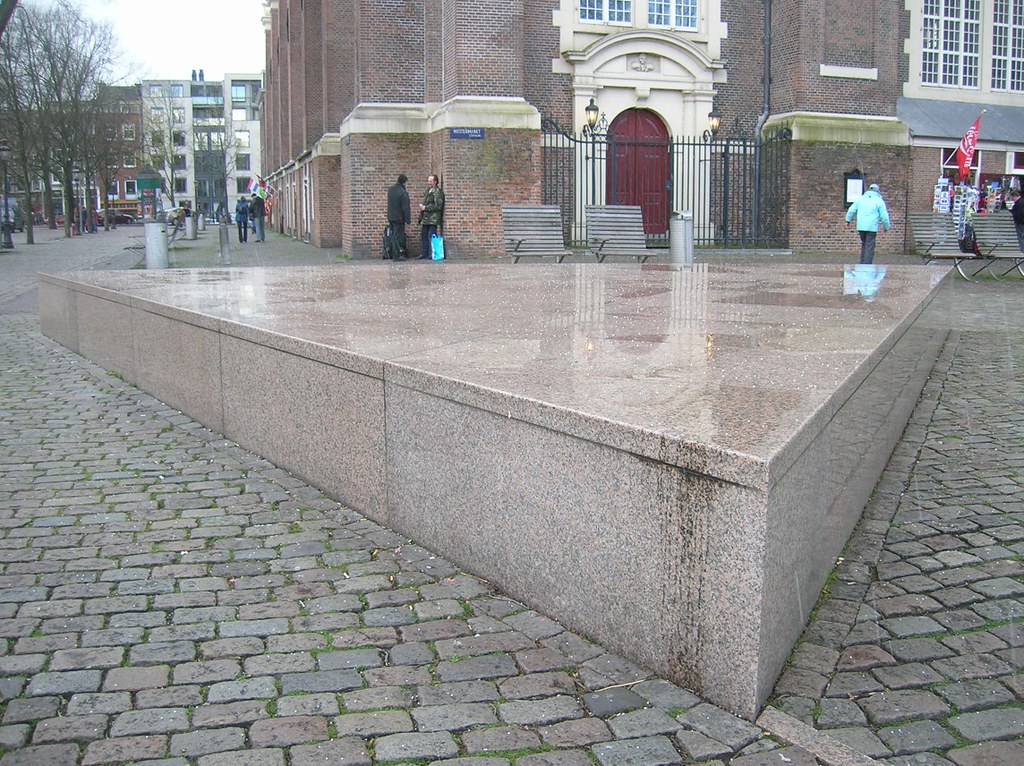Several impressive monuments can be found in Amsterdam's central districts.
These commemorate important aspects of Dutch heritage and pay tribute to significant events in European history.
Today, we're off to discover them.
Monument Amsterdam: article summary
Monument in Amsterdam: the national monument
The National Monument is located on the Dam square since 1952 and opens directly onto the Royal Palace. The base of this white stone obelisk is supported by several statues representing members of the Dutch resistance.
A sculpture of a woman holding a child stands above these male figures. It symbolizes peace and victory. The monument was designed to commemorate the Second World War and subsequent armed conflicts.

Homomonument
After years of campaigning and development, the Homomonument was unveiled in 1987. This large pink triangle was the world's first memorial to LGBTQ people murdered during the Holocaust.
The commune installed it to draw attention to ongoing and historic struggles. On days of commemoration and celebration, such as Pride Day or Liberation Day, commemorative activities take place around the Homomonument.
Monument in Amsterdam: Anne Frank House
During the Second World War, Anne Frank and her family hid from the Nazis in an apartment in De Jordaan. Eventually, the occupying forces found them, and Anne and her sister were sent to the Auschwitz concentration camp.
Today, visitors to Amsterdam can pay their respects to Anne Frank and her family in a museum located in the heart of the city. inside their ancient sanctuary.
Ons' Lieve Heer op Solder
Following the Netherlands' official conversion to Protestantism in the 16th century, the Dutch government banned Catholicism to ensure that the Papal States could not regain dominance over the country.
This meant that the remaining Dutch Catholics were forced underground and began to practice their faith in secret. During this period, several hidden churches are being built around AmsterdamThese include Ons' Lieve Heer op Solder, built in the attic of a townhouse.
Miraculously, this small, richly decorated chapel still appears intact and today serves as a museum.
Monument in Amsterdam: the Portuguese synagogue
In the 17th century, Amsterdam became a refuge for Jews fleeing the Spanish and Portuguese inquisitions. Many Jewish refugees made their way to Amsterdam, as it was one of the first cities in Europe to allow religious freedom.
Eventually, these immigrants became wealthy and decided to build a huge synagogue near the Jodenbreestraat, which is still a place of worship today. for Amsterdam's Jewish community.
Dutch theater
After invading Amsterdam, the Nazis ghettoized the city's main Jewish quarter and turned its theater into a transportation hub where people were rounded up and sent off. to transit camps on the German-Dutch border.
Monument in Amsterdam: the Amsterdam Royal Palace
Although now known as the Royal Palace, the magnificent building on the west side of Dam Square originally belonged to and served as the seat of the city council. This sumptuous structure, built in 1655reflects Amsterdam's burgeoning economic and cultural influence.
Eventually, it fell into the hands of the Dutch royal family, who now use it for ceremonial purposes. However, the Royal Palace opens to the public regularly hosts historical exhibitions.
The old church
Without taking into account renovation and reconstruction projects, the Oude Kerk has stood in the center of Amsterdam for almost 1000 years, making it the city's oldest building.
The Catholic church was taken over by Protestants during the Reformation. Although the church has undergone major alterations over the years, its wooden ceiling has remained intact since 1390, and is one of the most important works of art in the world. the most impressive structures of their kind in the world.
Amsterdam monument: Oudekerks Square
Ouderkerksplein is located in the center of the red-light district in Amsterdam, surrounded by hundreds of prostitution showcases. In February 1993, an anonymous artist added a small bronze relief to the square, depicting a hand resting on a pair of bare breasts.
Although its significance remains unknown, it is generally thought that the statue commemorates the city's sex workers. In 2007, another statue, called Belle, was placed on the square and clearly represents the neighborhood's prostitutes.
There are many sights to see in Amsterdam. Just follow my recommendations, you'll be able to enjoy the best of them during your stay.
What to do in Amsterdam in 1 day, 2 days, 3 days, 5 days, a week?
Whatever the length of your stay, I invite you to download my special Amsterdam guide.
It's free and in PDF format.
All you have to do is tell me below which e-mail address you'd like to receive it at.
EDIT: you can't enter your email?
Take the quiz at the top of this article and you'll be able to register your email address to receive the special Amsterdam guide!
Leave a Reply